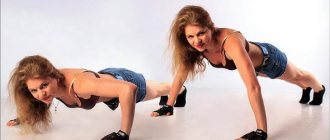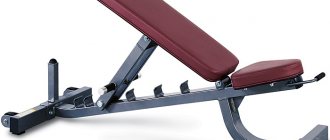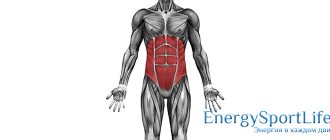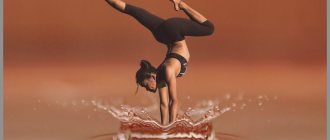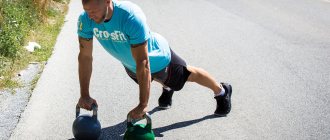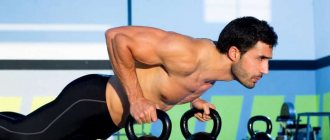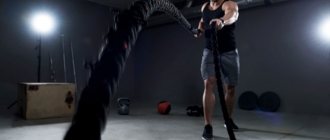How long should you exercise to build muscle?
By nature, humans are prescribed to have strong and functional muscles - this is our natural defense against injuries, endocrine disorders and other unpleasant health problems.
But some people go to the gym for years and don’t see much progress, while for others it is noticeable after just a month of training. So how much do you need to lift to see results and build strong muscles? Interestingly, skeletal muscles are not only muscles, but also organs. They contain many components, including muscle fibers, connective tissue, nerve tissue, and blood tissue. The largest muscle in the human body is the gluteus maximus, the smallest is the stapedius, which moves the bone of the middle ear.
Here's what to consider before you join a gym and start building muscle:
Any progress in training depends on several factors and always takes a long time. But the first results, plus or minus, will become noticeable in a month;
When starting a training program, you need to undergo an examination (at least an ECG and blood tests). And the older the person, the more relevant our advice. Especially if you have already been diagnosed with any problems with the heart or joints (for example, osteoporosis);
There are no universal recipes for building muscle. It all depends on your training goals.
How long does it take to build muscle?
This can be influenced by a number of factors, including the type of exercise itself. For people over 30 (especially men), training will be harder, and muscle mass will grow more slowly.
Let's not forget that men and women “grow” differently. The muscle/fat tissue ratio, average body size, and the combination of hormones all play a role here.
For example, this study compared muscle strength in both sexes. A rather obvious thing emerged: women not only have shorter muscle fibers (which reduces average strength), but also have a different distribution of lean muscle mass. And this also affects the difference in strength indicators with men.
How to train to gain muscle mass. Basic Tips
As was already said at the beginning, there is no universal recipe, set of exercises, magic products, secret serum, radioactive spider that will turn you into a superhero from the Marvel universe. It all depends on your training goals and your initial preparedness.
Exercises with your own weight or resistance exercises with rubber loops will be enough. This is exactly what you need if you have never gone to the gym before.
Here are some general exercises that may be useful:
Basic without weights (pull-ups on the bar, push-ups from the floor and parallel bars, squats and lunges);
Resistance exercises with loops;
Light weights (light dumbbells, medicine balls, etc.);
Strength training equipment and blocks.
At the initial stage, as a rule, two classes per week are enough for all major muscle groups: torso, legs, arms, back, shoulders. In this case, it is advisable to work through all of them in one workout. The base load should be such that you can perform 12 repetitions in one set.
At the first stage, you will inevitably suffer from muscle pain - this is the so-called sore throat. It's okay, all novice athletes have gone through this. The main thing is not to overwork, but also not to slow down. Focus on how you feel and everything will be fine.
The most effective exercises for biceps, triceps and forearms
To achieve optimal results, we recommend that you familiarize yourself with scientific research based on the principles of electromyography (recording muscle activity using a special device). And if you also turn to the experience of the best trainers in the world and learn something useful for yourself, then that will be wonderful. Make yourself a training plan and go ahead!
The opinions of top trainers regarding muscle function almost entirely coincide with the results of scientific research. This is probably no coincidence, since connoisseurs of the art of bodybuilding usually read scientific literature, update their knowledge, because it is very important for them to keep abreast of the latest changes in the field of sports (naturally, otherwise they would not be the best and most famous).
The most effective basic movements:
- Barbell lift (barbell disc, shoulder-width grip)
- Exercises with a bodybar or push-ups (for triceps growth)
The most effective additional movements:
- Concentrated dumbbell biceps curl
- Triceps Pull Down
Exercises that are most effective for the forearm muscles:
- Lifting the barbell with your fingers
- Forearm extension
It may seem to you that the exercises are not enough for the full growth of arm muscles, but believe me, these 6 exercises are the most effective and proven! They are exactly what you need for natural and gradual muscle growth. The training is structured in such a way that absolutely all the muscles of the arms, shoulders and forearms are involved.
You can complete your arm workout with an explosive superset (60-90 seconds rest between sets):
- Lifting bar 6*3
- Pull-ups on the horizontal bar 8*3
- Concentrated dumbbell curl for biceps 12*3
- Triceps pull down 12*3
- Lifting the barbell with fingers 15*2
- Forearm extension 15*2
How long does it take to pump up?
Well, now the main question that probably torments the reader and to which no one (including us) will give a short answer: how long do you need to sweat in the gym to pump up?
First of all, we don't know what "pumped up" means to you? Stay lean, but get sculpted abs, or build massive “cans” like Arnold?
Secondly, we don’t know your body type, whether you have health problems or are overweight. Obviously, if you are obese, you will first have to intensively remove the “ballast”, and only then think about building muscle. This may take up to six months.
Third, your progress will be directly affected by how serious you are. Any training is always a path of self-restraint and discipline. Without proper motivation, you won’t be able to pump up at all.
In general, at the moment there is not a lot of scientifically based work that would measure the rate of muscle growth in people. Offhand, we can name the Colorado experiment of physiologist Arthur Jones, carried out back in 1973. He found that an adult man who trained to failure and followed a regimen could gain 8 kilograms of muscle in a 12-week training cycle without the use of anabolic steroids. But this experiment had its limitations:
The participant was Casey Viator, a professional bodybuilder. True, before the start of the experiment, he seriously lost up to 75 kilograms and generally became seriously ill. But the hero had muscle mass;
Viator was a generally healthy young man, and the training split Jones put him on was super intense;
The training conditions were almost ideal. In fact, Viator just rocked, rested and ate. He did not sit in the office for 12 hours and did not travel on business trips, like most of us.
The Role of Diet in Building Muscle
The problem of nutrition cannot be ignored. Don’t believe the smart guys who say that you can get better on the usual three meals a day, or simply by increasing the portion size. This may be partly true at the initial stage and only while we are talking about the adaptation period. You can burn excess fat and build muscle only by thoroughly shaking up your previous diet.
Macronutrients
You are probably familiar with the abbreviation BZHU, or proteins, fats and carbohydrates. This trinity is precisely the necessary macronutrients. All of them are vital for our body.
Proteins are building materials that are broken down into amino acids during digestion. All our fabrics are essentially made from them. Proteins are also extremely important for the production of certain hormones, enzymes, antibodies and neurotransmitters.
Carbohydrates are a source of energy. They are divided into simple and complex. The former are broken down and absorbed almost instantly, the latter, respectively, slowly. It is very important that slow carbohydrates predominate in your diet, especially if you are overweight. Carbohydrates should account for 40-60% of calories in the daily diet.
Fats – are involved in metabolism and the absorption of important minerals and vitamins. And in all metabolic processes. We are primarily interested in unsaturated fatty acids and only partially saturated ones:
vegetable oils (extra-virgin olive, coconut, flaxseed, etc.);
Source
How to quickly pump up your arms with dumbbells
Dumbbells allow you to vary different exercises, and you can train with them either alternately or with two at the same time. First of all, you should think about safety. After all, even when training with light dumbbells, muscle rupture is possible. Therefore, it is worth reading the article How to properly pump up your arm muscles.
On the subject: The arm muscle hurts from the elbow to the hand, what to do?
Training your arms with dumbbells has some disadvantages: dumbbells do not allow you to give a concentrated load to the external or internal biceps separately.
Therefore, it is very important to create a competent training schedule, where the emphasis will be on pumping up the weakest parts of the arms.
Exercises for biceps
- Curling arms with a barbell. To perform the exercise you need to use a narrow grip. You can load both heads of the biceps and brachialis.
- Alternating dumbbell bicep curls. This is an effective exercise for gaining muscle mass.
- Concentrated biceps curl with dumbbells. Exercise for pumping up the middle and lower biceps.
Triceps Exercises
- Extension of arms on a block. Use a neutral grip. All 3 triceps bundles are loaded. This requires a special simulator with an upper block.
- Overhead extension with dumbbells. When performing, use a neutral grip. The triceps are stretched at the bottom, making the exercise more effective.
- Bent-over arm extension with dumbbells. This is an effective exercise that will help further strengthen your triceps.
Building weekly training plans
Let's look at the three most effective training options:
- Biceps can be pumped with the back, and triceps with the pectoral muscles. During back training, a good load is provided for the biceps. The same applies to the pectoral muscles and triceps.
- Triceps can be pumped with the back, and biceps with the pectoral muscles. This will help to vary the load on the biceps. This allows you to lift heavier weights.
- Conduct arm training on a certain day. Biceps and triceps can be trained in one session.
Optimal diet
To quickly pump up your arm muscles, you should both train well and eat right:
You need to consume about 15% more calories than you burn. This is explained by the expenditure of energy on muscle synthesis. It should be noted that the male body synthesizes a maximum of 3 kg of muscle mass per month. The optimal rate of weight gain is 3-4 kg per month. Eating plenty of protein. Protein is one of the key “building materials” for the human body. In order to ensure muscle growth, you should consume 1.5-2 g of protein per 1 kg of body weight per day. Eat food immediately after training. The sooner you eat after training, the better. Frequent meals. It is recommended to eat 4 times a day. The less often a person eats, the more fat will accumulate in the body. Same amount of calories daily
Compliance with this rule is very important. You need to eat the same way both on days without training and on days with training, because the body needs proteins, carbohydrates and even fats
Features of recovery after training
Recovery after training takes quite a long time. If the training was intense, then the muscles are in a state of subcompensation, i.e. their size decreases in comparison with what it was before classes. The body needs to overcompensate for muscles - to make them larger than before training.
Depending on the depth of muscle subcompensation, recovery may last
few weeks. The most optimal is short but intense training. You should work to the maximum of your capabilities.
Such training is very important, as it provides an adaptive response in the muscle. In order for muscle growth to continue, the intensity of the load must be constantly increased.
Exercises
After warming up, you can move on to the main exercises.
Arm exercises with dumbbells
Starting position: feet shoulder-width apart, back straight, chest forward, shoulder blades pulled together, elbows slightly bent.
Alternately, as you inhale, raise your straight arms forward to the chest line, and while exhaling, lower them to the starting position. During the exercise, do not raise your shoulders and do not lean your hand forward. Raising dumbbells in front of you gives relief to the front deltoids, that is, this will pump up your upper arms.
The following two exercises are the most effective for training your arms at home. If performed regularly at home, the first results will appear no later than 2 weeks.
Lowering your straight arms with dumbbells down, press your elbows to your body and alternately bend your arms at the elbows, lifting your hand from the dumbbells to your shoulder.
If we are working with a tape expander, then we perform the exercise of bringing the hand to the shoulder by standing in the middle of the tape and holding its edges in the hands. In the lower position, do not fully extend the elbow.
The exercise is often called a “hammer” or “hammer curl” and is performed with a neutral grip (when the back of the hand is turned outward in the starting position) or an underhand grip (when the palm faces the ceiling when lifting). Often, starting with a neutral grip, at the top point, at shoulder level, supination is performed (slightly turning the hand toward you).
The dumbbell biceps curl has many variations. Can be performed:
- with both hands at the same time;
- alternately, i.e. first only the right one, then only the left one;
- alternately: once with the right, once with the left.
From a standing, sitting, lying position.
When performing the exercise, it is important not to lean towards the working arm and firmly fix your wrists, do not throw the dumbbells. To pump up your arm muscles and avoid injury, you need to make smooth movements.
This is a triceps exercise. But depending on the execution options, it allows you to train other muscles.
- Raise both arms with dumbbells up, elbows slightly bent and looking forward. Bend your elbows, lowering your forearms back until they touch your biceps. As you exhale, we return to the original vertical position.
You can hold your hands parallel, squeezing one dumbbell in each, or you can connect your hands, working with one dumbbell as in the picture. Also, to change the load vector, perform the exercise “French dumbbell press” - performed lying down. Details of the implementation can be found in the article.
You can use the barbell with a palms-forward grip, the distance between the hands is about 10 cm.
If a rubber or spring expander is selected, then the upper row is performed, for example, from the “scissors” position, when one leg is pulled back and holds the end of the expander, the other end of the elastic band is clamped in the working hand. The trajectory of the forearm movement is the same as when working with a dumbbell.
On the subject: Is it possible to pump up your biceps with dumbbells every day?
- With your arms raised up, if in the initial position they are parallel, you can bend your elbows, tilting your forearms with a small amplitude to the right and left.
- Another triceps exercise allows you to work your upper biceps at the same time. We bend our knees, tilt our body a little forward, and move our straight arms down and back, so that our elbows look at the ceiling. We bend the elbows towards the shoulder, and then return the forearm to its original position. In this exercise, only the forearm works, the upper part of the arm from the shoulder to the elbow is motionless in a backward position.
Triceps exercises can be performed standing or sitting.
- Wrist flexion and extension.
If the biceps and triceps are sufficiently pumped up, and the forearm looks disproportionate in comparison with them, which is unlikely in girls, you can train the forearm muscles separately after working on the biceps. The main exercise is flexion (underhand grip) and extension (overhand grip) of the arms at the wrists in a sitting position. Here is one possible exercise.
We take a sitting position, so that the knee of the supporting leg looks slightly toward the floor (this increases the load compared to a horizontally positioned knee), we place the elbow on the prepared leg, and take the dumbbell with an underhand grip, so that the palm looks exactly up.
We lower the weighted wrist as far back as possible and slowly bend it towards ourselves, the other hand is motionless. Only the forearm muscles work.
You can complicate the exercise by increasing the amplitude by lowering the dumbbell to an extremely low position, when it is held only on the bent fingers of the palm laid back. Then the fingers are gradually twisted and then the entire wrist is raised. This complication simultaneously strengthens the fingers and stretches the muscles and tendons of the forearm.
After 10 executions, we turn the hand 90 degrees, so that the fingers look to the side, and the dumbbell clamped in them is vertical, and with the maximum possible amplitude, we slowly bend and straighten the wrist up and down.
The hand should be relaxed, and the movement is carried out by the muscles of the forearm. After 10 repetitions, we again turn the hand 90 degrees, so that the closed fingers look at the floor, and repeat the flexion-extension movements 10 times.
It is important to tense your hand here; you can tilt your body to the side to fully load your forearm.
Parterre
Push-ups are the most popular bodyweight exercise.
From a lying position, arms shoulder-width apart, bend your elbows, lowering your straight body to the floor. The lightweight version is performed from a lying position with support on the knees, hands parallel, fingers facing forward, abs tense.
You can do three springs (lower your chest to the floor three times and raise it without straightening your elbows to the end), and on the fourth count return to the starting position. Repeat 10 times.
- Reverse push-ups (dips).
We place our hands shoulder-width apart at the back, legs extended forward, you can bend your knees a little. Bend your arms until your elbows are parallel to the floor. We return to the starting position.
Exercises on the horizontal bar
- Hanging on the bar. The longer you hang, the better - it trains arm endurance and stretches the spine.
- Pull-up, overhand grip. First, you need to master 3-5 pull-ups, then increase the number to 10 times.
- Reverse grip pull-up.
Anatomy of hands
In order to know how to pump up your arms, you need to delve into the anatomical component and understand that they consist of two main muscles - biceps (biceps brachii) and triceps (triceps brachii), each of which performs its own anatomical function. The function of the biceps is to bend the shoulder at the shoulder joint, and the forearm at the elbow, and the triceps is to move the arm back and bring the arm to the body; the entire muscle takes part in extending the forearm.
The biceps muscles include 2 muscle areas:
- short head (inner side of the biceps), located closer to the body, has a shorter length compared to the long one (1);
- long head (outer side), located on the outer part of the arm, has a greater length compared to the short one (2);
The triceps muscles include 3 muscle parts:
- long or inner part - located closer to the body;
- lateral or external part - located on the outer side;
- medial or central part - located inside the long and lateral parts;
By and large, this knowledge is enough to visually represent the work of muscles performing certain movements, which will allow you to focus exclusively on working the target muscle.
So, to summarize, we conclude that the function of the biceps is to flex, and the triceps is to extend. Knowing this, it becomes clear how to pump up your biceps and triceps, which together will invariably help you create huge arms.
Options for home
When considering ways to pump up your biceps without dumbbells, you should consider two options:
- training without any equipment;
- and training with your own body weight in the presence of a crossbar.
Bicep push-ups
This is the only exercise that can be done on the floor for biceps. It is important to perform the movement not in quantity, but at a slow pace and under control, feeling the tension in the target muscle.
Technique:
- Assume a push-up position, but place your hands at stomach level. Turn your palms to the side and away from you (at an angle of 45 degrees).
- Do push-ups, bending your elbows, try to lower your body so that your chest is 1-2 cm from touching the floor.
- Straighten your arms with a powerful movement and repeat the movement.
This exercise may seem difficult at first, so try to perform 5-6 repetitions per set, gradually increasing the number of repetitions to 10 or even 15.
Biceps pull-ups on the horizontal bar
If you have a bar, this is the main movement with which you can pump up impressive volumes of biceps. In addition to the biceps brachii, it also uses the rest of the muscle areas of the arms, as well as the anterior deltoids. This can be considered an advantage, as it helps to increase the total mass of the shoulder girdle and upper limbs.
Technique:
- Hang from the bar, holding it with an underhand grip. Place your hands optimally at shoulder width.
- Pull yourself up, trying to pull your chin towards the bar.
- Pause, then return to the starting position at a slower pace.
Horizontal pull-ups
This is a movement that works with any low bar, raised support, TRX loops, or other devices that allow you to grab your hands at chest or stomach level.
Technique:
- Grab the bar with an underhand grip. Tilt your body so that you rest on your heels. The body should be straight from the feet to the shoulders and neck.
- Bend your elbows, trying to bring your upper chest to the bar as close as possible.
- Pause and slowly return to the starting position.

If there is no low bar, then you can do pull-ups on a table with a straight grip.
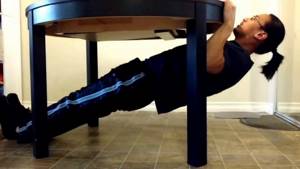
Newbie mistakes
The first and most common misconception of new gym goers is the misconception that the more biceps exercises they do during their workout, the bigger their arms will become. In reality, everything happens completely differently and the hands may not only increase, but, on the contrary, become even smaller than they were. And yet, how to quickly pump up your arms? In order to answer this question, it is necessary to apply a slightly different strategy for pumping up your arms. Small muscle groups that do not constantly experience extreme stress in everyday life simply do not need to receive a lot of stressful weight, because their function is only to flex and extend. Therefore, to begin with, the muscles need to be “trained” to experience a more powerful impact using a progression of loads (a gradual increase in training weight).
If the arm muscles are overloaded with an abundance of exercises from the very beginning, then no growth should be expected, they simply will not have time to recover, and the damaged areas will use the nearby muscles to heal. In other words, pumping your arms a lot is completely useless, and in some cases even harmful.
Of course, the response to the strategy of progressive loads can be expected to be muscle growth and an increase in arm volume only if, along with them, basic basic exercises are performed to increase total body mass. How to properly pump up your arm muscles can be understood by watching more experienced athletes. You will never see large and powerful hands on a weak, emaciated body.
The second misconception is the misconception that pumping your biceps will make your arm bigger. Everything is exactly the opposite. The biceps takes up 1/3 of the arm's volume, while the triceps take up as much as 2/3
It is also fundamentally important to maintain a balanced diet for weight gain, consuming sufficient amounts of microelements necessary for overall muscle growth
Therefore, in order to increase the volume of your arms as effectively as possible, it is most beneficial to give your priority to triceps exercises. At the initial stage, building a separate arm day into your training plan is, to say the least, ineffective. The smartest thing to do is to add arm training to your core muscle training routine. An important condition is to pump all muscle groups (legs, pectoral muscles, back, abs), and not individual components.
And the third, very significant misconception is that the more weight you put on the apparatus, the faster you will be able to pump up your huge arms
Again, paying attention to the training of famous athletes who have already pumped up huge arms, you will notice that their arms are pumped up with relatively small weights
Conclusion: biceps and triceps training at the initial stage should be divided into separate days, always after basic basic exercises to increase total body weight. An increase in total body weight entails an increase in the volume of the arms. Compliance with the diet (including a protein diet) is a fundamental point in gaining muscle mass.
On topic: Increase arm volume in one workout
Building arm muscle mass: 8 rules
1) Warm up . Warm-up should always come first. Don’t underestimate it, because you can very easily get injured and say goodbye to your dream. Warm up properly, focusing on the target muscle group.
2) Biceps and triceps (small muscle groups) grow ONLY in conjunction with large muscle groups (LEGS, CHEST, BACK). Therefore, attempts to build muscle mass in the arms while ignoring other large muscle groups are reduced to zero.
3) Biceps and triceps, ideally, should be trained together alternating exercises. Remember, you should always start with the biceps, and not vice versa (training the triceps). Otherwise, the triceps will limit the strength in biceps curls. Always start with the biceps.
4) Use heavy compound exercises at the beginning of your workout. They are best for building muscle mass and strength. At the end of the workout, you can add pumping and finish working on your arms.
5) By developing the Brachialis (the muscle that runs under the biceps on the outside of the arm), the biceps will appear longer with a fuller shape. The best exercises for brachialis are HAMMERS and REVERSE GRIP ARM Curls.
6) In each exercise of each approach, reach the point of complete failure of the arm muscles.
7) Be sure to strive to increase the working weights at each workout, BUT NOT AT THE DUE TO LOSS OF TECHNIQUE. Perform the exercises slowly and under control (this will also give you the opportunity to exclude all other muscles from the work except the target, in our case, the biceps).


Good luck!
Shall we turn on some music to set the mood?
Now playing:
Open Kluber FM website | iOS app | Android app
How you can quickly pump up your biceps at home
As we wrote above, you can use a horizontal bar for this purpose. However, there are some subtleties that should be taken into account:
- Pull up with a reverse grip.
- At the same time, try not to have a wide grip. It is this positioning of your hands that will allow you to quickly pump up your biceps at home.
- Do several approaches, approximately three to five. Do at least eight pull-ups at a time.
- The approach system can be replaced with a more interesting one - a “ladder”. It is perfect if you are working out with someone in pairs or with friends. The essence of the game is that you do not pull yourself up ten times, but sequentially - starting from one, gradually increasing the number of times up to ten, after which you “come back” back. It is worth noting that this game is actually quite exhausting - in total you will do a hundred pull-ups.
If you have obtained, or have already acquired, hardware, then things will go much faster. If you want to pump up your biceps, then you need to bend your arm at the elbow very often, while putting a load on it. In addition, there are two types of flexion: full and incomplete. It is their type that determines how your biceps will change. So, for example, an incomplete range of motion is better suited for working on “relief”, while a full range of motion is better suited for working on muscle mass. Very often, to limit movements at home, they use any support that you can rest your elbow on. Typically, these exercises are suitable for dumbbells.
If you have a barbell, then your actions will be slightly different. At the very beginning of training, you should decide on the weight of the load used. Here you should find a middle ground, because the quality of the exercises performed and their effectiveness will depend on this value. For example, if you hang a very heavy load, then after a large number of repetitions your technique may begin to limp. If you use a smaller load, then for better efficiency you will need to spend more time.
As soon as you solve the problem of the weight of the projectile, you can move on to classes. The technique of performing the exercise is very simple:
- Position yourself near good support. A wall is perfect for this.
- Grasp the barbell with an underhand grip.
- Straighten your back, standing straight against the wall.
- Start lifting the barbell towards your chest. Watch the position of your elbows - they should not move.
This is exactly what exercises for the full amplitude of flexion look like. In it, the main load goes to the biceps and back muscles, although only if you do not move your elbows. In addition to the above subtleties, it is worth considering one more thing: when you lower the barbell, try to keep your arms slightly bent and tense. This simple technique will provide you with an increased load on your muscles and improve the quality of your workouts. Also try to lower the bar as slowly as possible.
If you intend to do “relief”, then first of all you need to think about support, although in this case you may have problems. The best solution to the problem would be to visit the gym and train on special machines, or use unique household items - for example, a bench.
As you may have noted, in terms of home exercises, dumbbells have an undeniable advantage over a barbell. In addition to simplicity and convenience, using dumbbells allows you to load each arm separately and adjust the load on it. An ordinary stool is often used as a basis for training with dumbbells, on which the exercises are done in a sitting position. In this case, the thigh serves as a support. It is worth noting that before any activity you should definitely warm up and warm up your muscles - this will allow you to avoid injuries.
We hope that our article on how to quickly build biceps at home will be useful to you. Good luck with your training!
Training complex of 6 exercises for beautiful hands for women
It is possible to form a beautiful arm line and elastic muscles with the help of a special set of exercises aimed at the forearms.
This is the area that many girls find problematic. Fat deposits are deposited in this area, and the skin may also sag due to muscle weakness. Strength training will give results in just two months. The muscles will become stronger, their relief will appear. The condition for this result is regular training according to our system, even at home.
How to pump up your arms correctly
Slow supersets
For example, when performing a superset of barbell curls and a French bench press, after 1 exercise, do not immediately proceed to the second, but rest for exactly 2 minutes, then perform a French press, rest again for 2 minutes and repeat the circle again.
Such a mini-rest will help you take on more working weight and allow the muscles to feel a new load with an unusual rest interval; all this will prevent the muscles from getting used to the load and will ensure an increase in sports results.
Long rest
Set aside 1 day specifically for training your arms, perform a set of 8-12 repetitions and rest for up to 10 minutes before starting the next approach, thus performing up to 10 approaches during the workout.
Of course, this workout will take a lot of time and only 1 muscle group will be trained, but this will allow the muscles to recover well at the same time and take on fairly decent weights, which will be an advantage for mass and strength.
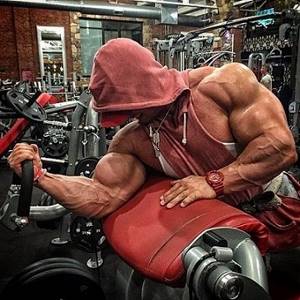
Workout for two
In order to maximally load your arms, you need a partner who, in case of muscle failure under heavy weights, will be able to provide insurance and pick up the barbell or dumbbells before they cause injury to you.
But in our case, we will go further, first do warm-up 12-15 repetitions for 2 sets of barbell curls, then stand in front of each other with a partner and perform the exercise for 8 repetitions, after which pass the barbell to your partner, who should also do 8 repetitions, after which the barbell returns to you again and you again lift the barbell for 8 repetitions.
You should continue until the barbell falls out of your hands, this will allow you to maximally activate muscle fibers and get super benefits from the exercise, and the spirit of competition will force you to lift the barbell again and again, pure psychology to be a winner, but it is worth remembering that this training method You should not use it more than 1-2 times a month, otherwise overtraining will occur and the recovery period will take a long time.
Don’t focus on just exercises, it won’t bring tangible results.
Time to recover
The arm muscles are made up of small and large muscles, and some muscles tire faster and take longer to recover than others. Therefore, train your arms according to the 2-1 scheme, this means that for the first week train your arms 2 times a week, and for the second 1 time a week, then the scheme is repeated, 2 times a week and again 1 time, and so on.
This will allow unrecovered muscles to quickly return to a state of combat readiness before the next workout and train your arms more effectively.
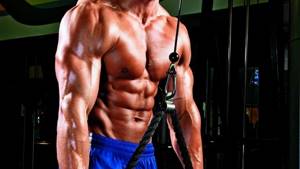
Change of exercises and variety of workouts
Don’t get hung up on the same exercises; when you start training, there will always be favorite exercises and the most inconvenient ones. Therefore, you need to change the exercises periodically, uncomfortable and difficult exercises just indicate that the muscles are not accustomed to the load, they have not yet adapted and the return from the exercise is maximum.
Alternate exercises with a barbell and dumbbells, with your own weight and in simulators, do exercises at different angles and in different amplitudes, this will allow you to fully load your muscles, making them more powerful and voluminous.
Slow reps
Change the usual pace of the exercises, after a quick rise, lower the weight 3-4 times slower, this will increase the time of load under which the muscles are located, which will not allow it to rest for a long time and will allow you to maximally involve many muscle fibers in the work.
On the subject: How to develop arm muscle strength exercises
You should not always do this, since this method of pumping up your arms requires more strength than usual, so perform this technique 1-2 times a month or, in the very last approach, exercise your arms. During the exercise, you need to concentrate as much as possible on the feeling of the muscle being trained.
Use these methods of pumping up your arms and remember that without proper nutrition and sufficient recovery time, all your efforts will be wasted!
Watch this video on YouTube
How to pump up your arms in the gym
Those who can visit the gym should try the following exercises to pump up their biceps:
- Scott Bench Curl. This exercise machine fixes your arms, preventing unnecessary muscles from working. Each set will put maximum stress on your biceps.
- Seated arm curl. Performed with the elbow of the working hand resting on the thigh.
- Standing arm curl. Feet shoulder-width apart, hold the dumbbell with an underhand grip. Bend your arm so that the projectile is at shoulder level. All movements are performed slowly.
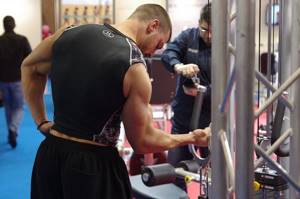
No less attention should be paid to the triceps during training. It is impossible to pump up your arms quickly without properly working out the triceps muscles.
The following exercises will be effective for beginners and others:
- Dips. They are done in a vertical position with a straight body. We lower the body slowly, trying to sink down as much as possible. At the same time, the elbows are pressed close to the body.
- Narrow grip push-ups. They differ from regular push-ups in the position of their hands, which are placed on the floor a few centimeters from each other. Arm curls are carried out to the point at which the shoulders are parallel to the floor. Read: floor push-up program.
- Dumbbell bench press. Lie on a bench, holding dumbbells at chest level with a hammer grip. Forearms point vertically. Straighten your arms up, then slowly return them to the starting position.
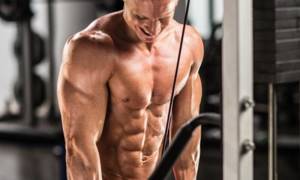
How to quickly pump up the muscles of your forearms? Using the following hand exercises:
- Wrist flexion. Sit on a bench with your feet shoulder-width apart. Place your forearm on the surface of your thigh, first grasping the dumbbell with an underhand grip. Lower the projectile by straightening your wrist. Slowly bend your wrist.
- We pump our wrists while standing. We stand with our feet shoulder-width apart. The dumbbell is held with an overhand grip. We extend the wrist, raising the hand as high as possible.

It is not enough to pump up the muscles in your arms; you also need to take care of pumping up your shoulders. You can make your deltoids bigger by doing the following:
- Raising arms with dumbbells to the sides. Performed standing, feet shoulder-width apart. The arms are on the sides of the body. Extend your arms to the sides, raising them to shoulder level. Slowly lower down to the starting position.
- Raising your arms with dumbbells in front of you. We become the same as in the previous exercise. The dumbbells are held with an overhand grip. Slightly bent arms are brought forward to shoulder level, after which they slowly return to their original position.
- Bent-over dumbbell raises. We place our feet shoulder-width apart, tilt the body so that the back is parallel to the floor, and arms down. Without straightening your back, we spread our arms to the sides, then slowly return to the starting position.
If you are wondering how to pump up your arms quickly, you need to strictly follow the recommendations above. Constant training and proper arm exercises will help make your muscles strong and defined in no time.
Basic set of exercises
- Stand straight and bend your knees. Take dumbbells and bend your elbows. Palms face up, the angle between the shoulder and forearm is 90 degrees. Slowly lower your right hand down, then your left. Repeat the exercise 8-12 times.
- Stand up straight and raise your dumbbells straight above your head. Lower your hands behind your head so that your elbows point up. Slowly straighten your left arm. Hold for 2 seconds and return to the starting position. Do the exercise for your right hand. Repeat the exercise 8-12 times.
- Stand up straight and bend your left arm at the elbow so that the dumbbell touches your shoulder. Hold this position for 2 seconds and perform the movement with the other hand. Repeat the exercise 8-12 times.
Remember that muscle growth does not occur during fitness, but during rest. Muscle loading occurs until the moment when work begins at the cellular level, at which protein synthesis occurs. This, in turn, thickens the fibers that make up the muscle. This process begins 2-4 hours after the end of the workout and continues for 24 hours.
bicepstriceps
How the program works
We do not suggest working exclusively with your hands for 29 days. On the contrary, continue to do the main program in parallel. In fact, research has shown that general exercises help maximize the growth of your biceps, triceps, and forearms by producing extra testosterone.
So, instead of dedicating a separate day to training your arms, simply add these exercises to the end of your regular workout.
Don't forget about your diet. To gain additional muscle size, you need to eat significantly more than before starting the program. But instead of focusing on the right amount of calories, just add a couple of protein shakes to your diet. That's all. The first will add 200-400 extra calories to your daily requirement, and the second will help your muscles grow faster.
As for sets of exercises, there are only two of them: Workout A and Workout B. Alternate them two to three times a week. For example, in the case of three classes a day, the sequence will look like this:
- Week 1: A, B, A.
- Week 2: B, A, B.
- And so on…
Please note that the number of approaches for some exercises is marked with an asterisk. This means that each new week you need to add one additional set.
For example, for exercise A2 in Workout A, do 5 sets in the first week, 6 in the second, 7 in the third and 8 in the last.
Believe me, such a systematic increase in training, while maintaining high intensity, works wonders on the biceps, triceps and forearm muscles.
Workout A
A1) Alternating arm curls with dumbbells
Approaches: 5*. Reps: 8. Rest: none.
Avoid rotating your body. Use only your hands to lift weights.
A2) Close grip pull-up
Approaches: 5*. Reps: 5. Rest: 30 sec.
Hang on the horizontal bar with a narrow grip and palms facing you. Squeeze your shoulder blades together and pull yourself up until your chin reaches the level of the bar. If you can, use a weight belt or vest.
B1) Close grip bench press
Sets: 3. Reps: 5. Rest: 30 sec.
Lie on a bench with your back, squeeze your shoulder blades together, and place your feet on the floor. Take the bar with a close grip and press, keeping your shoulders straight. Tighten your body right down to your heels, without lifting your buttocks from the bench.
C1) Curling arms with dumbbells with a “Hammer” grip
Sets: 3. Reps: 15. Rest: 30 sec.
Hold a pair of dumbbells with your palms facing your body. Bend your arms at the same time, raising them to your shoulders.
C2) Pull down rubber loop
Sets: 3. Reps: 50-75. Rest: 30 sec.
Attach the loop to a stable object above your head and grab the other side with both hands. Keep your shoulders still and extend your elbows all the way. Take the loop in a place where the level of resistance allows you to do 50-75 repetitions until fatigue.
